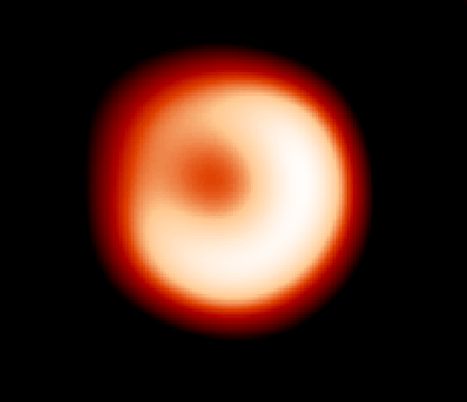
|
Credit & Copyright: Peter
Tuthill
(Sydney
University Physics Department) et al.,
W.M. Keck Observatory
Explanation:
You'd need a really big cup of
coffee with this doughnut ...
because the hole in the middle is about a billion kilometers
across.
Centered on the Sun, a circle that size would lie
between the orbits of Mars and Jupiter.
In fact, this doughnut is known to surround a massive newborn star
cataloged as LkHa 101
which lies in the
constellation Perseus.
Imaged
in infrared light, the tantalizing torus-shaped cloud of gas
and dust
is slightly tilted to our view.
The cloud's material may well be the ingredients
for the formation of a
distant
solar system.
A bright source of
ultraviolet light,
the hot young star itself is much fainter in the
infrared and so not visible in this picture.
Still, the star's presence is indicated as its intense stellar wind and
radiation has apparently carved out the doughnut's hole.
This premier close-up of a stellar system in formation was accomplished
by adapting a powerful observational technique
called
interferometry to planet Earth's largest single mirror
telescope, the 10 meter Keck.
|
January February March April May June July August September October November December |
| ||||||||||||||||||||||||||||||||||||||||||||||||
NASA Web Site Statements, Warnings, and Disclaimers
NASA Official: Jay Norris. Specific rights apply.
A service of: LHEA at NASA / GSFC
& Michigan Tech. U.
Based on Astronomy Picture
Of the Day
Publications with keywords: extrasolar planet - infrared - dust cloud - star formation - doughnuts
Publications with words: extrasolar planet - infrared - dust cloud - star formation - doughnuts
See also:
- APOD: 2025 September 8 Á IRAS 04302: Butterfly Disk Planet Formation
- APOD: 2025 July 10 Á Lynds Dark Nebula 1251
- APOD: 2025 June 23 Á W5: Pillars of Star Formation
- APOD: 2025 April 28 Á Gum 37 and the Southern Tadpoles
- APOD: 2025 March 26 Á Star Formation in the Pacman Nebula
- APOD: 2025 February 23 Á Saturn in Infrared from Cassini
- APOD: 2024 November 18 Á Stars and Dust in the Pacman Nebula
